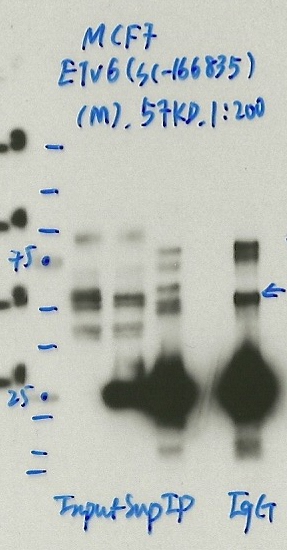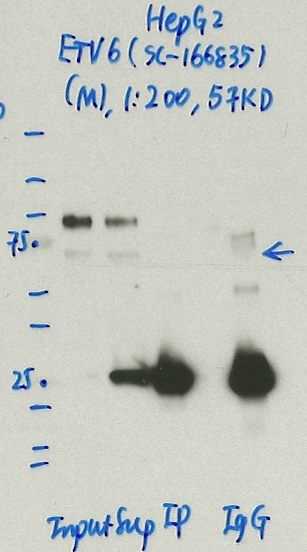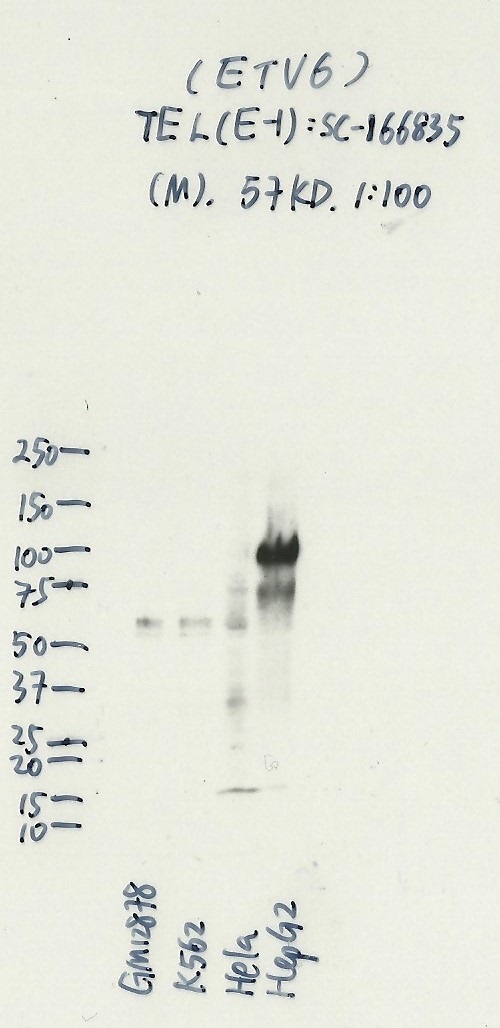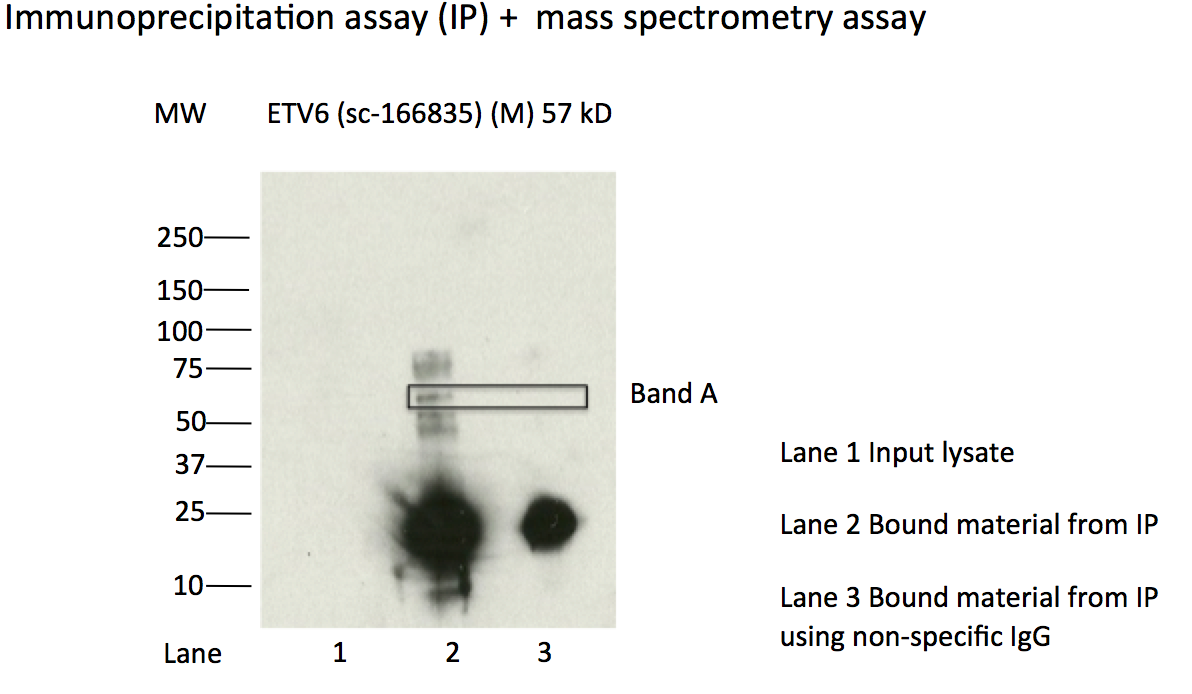ENCAB997CJG
Alternate accession: ENCAB038PAT
Antibody against Homo sapiens ETV6
Homo sapiens
K562, GM12878
characterized to standards
Homo sapiens
any cell type or tissue
partially characterized
Homo sapiens
HeLa-S3, HepG2
not characterized to standards
- Status
- released
- Source (vendor)
- Santa Cruz Biotech
- Product ID
- sc-166835
- Lot ID
- B1711
- Characterized targets
- ETV6 (Homo sapiens)
- Host
- mouse
- Clonality
- monoclonal
- Isotype
- IgG1
- Antigen description
- raised against amino acids 119-332 of TEL of human origin
- Aliases
- michael-snyder:AS-285
- External resources
Characterizations
ETV6 (Homo sapiens)
not submitted for review by lab
- Caption
- Immunoprecipitation was performed on nuclear extracts from the cell line: MCF-7, using the antibody sc-166835. The blot shows western blot analysis of input, flowthrough, immunoprecipitate and mock immunoprecipitate using IgG.Molecular Weight: 57.0
- Submitted by
- Denis Salins
- Lab
- Michael Snyder, Stanford
- Grant
- U54HG006996
ETV6 (Homo sapiens)
not submitted for review by lab
- Caption
- Immunoprecipitation was performed on nuclear extracts from the cell line: HepG2, using the antibody sc-166835. The blot shows western blot analysis of input, flowthrough, immunoprecipitate and mock immunoprecipitate using IgG.Molecular Weight: 57.0
- Submitted by
- Denis Salins
- Lab
- Michael Snyder, Stanford
- Grant
- U54HG006996
ETV6 (Homo sapiens)
GM12878K562HeLa-S3HepG2
compliant
- Caption
- Western blot analysis of nuclear lysates prepared from multiple cells lines loaded in the order: GM12878, K562, HeLaS3, HepG2 using the antibody sc-166835. Molecular Weight: 57.0
- Reviewer comment
- Multiple bands in HeLa-S3 and HepG2 lanes that would require a knockdown rescue to be compliant.
- Submitted by
- Nathaniel Watson
- Lab
- Michael Snyder, Stanford
- Grant
- U54HG006996
- Download
- ETV6-WB-333.jpg
ETV6 (Homo sapiens)
Method: immunoprecipitation followed by mass spectrometry
compliant
- Caption
- IP followed by mass spectrometry: Briefly, protein was immunoprecipitated from K562 whole cell lysates using sc-166835, and the IP fraction was loaded on a 10% polyacrylamide gel (NuPAGE Bis-Tris Gel) and separated with an Invitrogen NuPAGE electrophoresis system. The gel was silver-stained, gel fragments corresponding to the bands indicated were excised and destained using the SilverSNAP Stain for Mass Spectrometry (Pierce). Then proteins were treated with trypsin using the in-gel digestion method. Digested proteins were analyzed on a LTQ-Orbitrap (Thermo Scientific) b the nanoLC-ESI-MS/MS technique. Peptides were identified by the SEQUEST algorithm and filtered with a high confidence threshold (protein false discovery rate <1%, 2 peptides per protein minimum).
- Reviewer comment
- Excised band shows factor of interest but several other immunoreactive bands were not analyzed.
- Submitted by
- Kathrina Onate
- Lab
- Michael Snyder, Stanford
- Grant
- U54HG004558
- Download
- ETV6_final Sheet1.pdf
ETV6 (Homo sapiens)
K562
exempt from standards
- Caption
- Immunoprecipitation of ETV6 from K562 cells using sc-166835. Lane 1: input nuclear lysate. Lane 2: material immunoprecipitated with sc-166835. Lane 3: material immunoprecipitated using control IgG. Band A was excised from gel and subject to analysis by mass spectrometry. Expected band size ~57kD.
- Submitter comment
- We cut the band based on the size, it's hard to be exact.
- Reviewer comment
- How come not all immunoreactive bands were excised for mass-spec analysis? ETV6 is detected in the excised band though.
- Submitted by
- Kathrina Onate
- Lab
- Michael Snyder, Stanford
- Grant
- U54HG004558
- Download
- ETV6_IP.png



